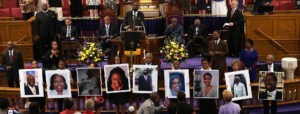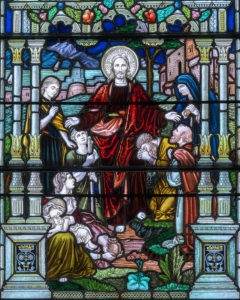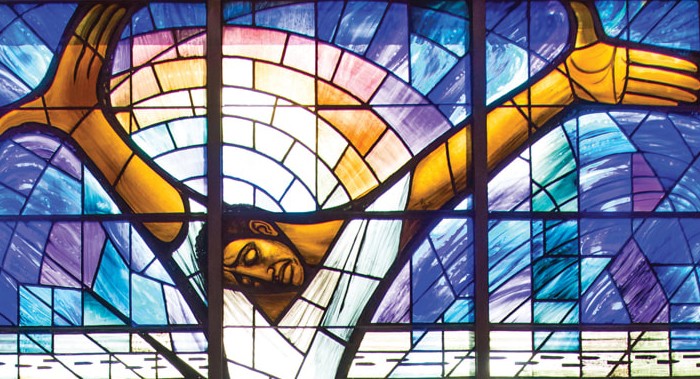Dylann Roof, the white Christian man who murdered nine African Americans during the closing prayer of a Bible study at Mother Emanuel AME Church in Charleston in 2015, was back in the news recently after a federal appeals court upheld his conviction and death sentence.
Before I go any further, I want to pause and honor those whose lives he ended. You can read more about each of them here, and read about the events focused on healing at the six-year anniversary this past June here.

Photographs of the nine victims killed at the Emanuel African Methodist Episcopal Church in Charleston, S.C., are held up by congregants during a prayer vigil at the the Metropolitan AME Church June 19, 2015 in Washington, D.C. (Photo by Win McNamee/Getty Images)
I invite you to take a moment, breathe in, and say their names — not just in your head but aloud, slowly :
- Sharonda Coleman-Singleton
- Depayne Middleton-Doctor
- Cynthia Hurd
- Susie Jackson
- Ethel Lance
- Clementa Pinckney
- Tywanza Sanders
- Daniel Simmons
- Myra Thompson
In their rejection of Roof’s appeal, the 4th U.S. Circuit Court of Appeals in Richmond issued a strongly worded condemnation of his violent actions:
Dylann Roof murdered African Americans at their church, during their Bible study and worship. They had welcomed him. He slaughtered them. He did so with the express intent of terrorizing not just his immediate victims at the historically important Mother Emanuel Church, but as many similar people as would hear of the mass murder… . No cold record or careful parsing of statutes and precedents can capture the full horror of what Roof did.
But the recent AP story, like nearly all mainstream media coverage of Roof over the last six years, makes no mention of Roof’s own Christian faith — a faith that was not just incidental to, but constitutive of, his white supremacist worldview.
At the time of the mass murder, Roof was a baptized member in good standing at St. Paul’s Lutheran Church in Columbia, S.C. Notably, this church is affiliated with the ELCA, a denomination that is the more progressive mainline Protestant — not the more conservative and southern evangelical Protestant — branch of the white Christian family tree. According to relatives, Roof regularly went to church, including catechism classes, growing up.
Roof’s own journal, written in prison while he was awaiting trial and subsequently entered into evidence by the prosecution, shows how tightly woven together Christianity and white supremacy were in his worldview. There, he called on whites to reform American Christianity, to transform it from being “this weak cowardly religion” to become “a warrior’s religion.”
“The most disturbing thing in Roof’s journal is that it is filled with Christian imagery.”
But to me, the most disturbing thing in Roof’s journal is that it is filled with Christian imagery, including a full-page drawing of a resurrected white Jesus emerging from the tomb. It’s the only non-data image I included in my book, White Too Long.
Such images of a white Jesus, in stained glass and portraits, are commonly found in white Christian churches throughout the country, even today. They were designed, consciously and unconsciously (and this is where it is most powerful, when it is taken for granted) to represent the Son of God as a member of what they believed to be the dominant race.

Stained glass window inside of St. Paul’s Episcopal Church in Richmond, “Jesus Healing the Sick” (Shutterstock)
For example, recently I revisited St. Paul’s Episcopal Church in Richmond, often dubbed the Cathedral of the Confederacy because it served as the home church to both Confederate President Jefferson Davis and Gen. Robert E. Lee during the Civil War. The church has been in the news over the past six six years because it has been in the process of removing the large number of Confederate symbols from its sanctuary, work that began in response to the 2015 massacre at Emanuel AME.
Under the ongoing work of its History and Reconciliation Initiative, in 2020 the church also removed additional plaques that were associated with Lost Cause ideology and rededicated three stained-glass windows, shifting the objects of their devotion from Davis and Lee to “the glory of God.”
The efforts at St. Paul’s are laudable and sincere and in many ways provide a model for how white churches can deal with the legacy of white supremacy that has too long dwelled among us. But what has escaped scrutiny is the most central image in the sanctuary: the white Jesus that fills the large central window behind the pulpit.
St. Paul’s is not alone in having this blind spot. Just this year, I had the jarring experience of participating in a Zoom meeting on racial justice, where one of the clergy leaders was standing beneath the gaze of a similarly imposing white Jesus in not-so-stained-glass.
These images perform unacknowledged but powerful theological work. For the skeptics, just a few experiments would likely reveal how strongly many Christians remain invested in the whiteness of Jesus, which is rooted in underlying beliefs about white supremacy:
- How would your church react to a move to replace all images of Jesus, including stained-glass windows and paintings, that depict Jesus as someone of European descent with more accurate depictions of a Jesus of Middle Eastern descent?
- How would a non-white Jesus impact the ways white Christians you know think of a personal Savior and the theology of salvation? How comfortable would they be with letting a brown-skinned Jesus “come into their hearts”?
- How would they react to an illuminated Baby Jesus in the nativity scene in front of the church that was brown instead of white?
- And how would a non-white Jesus impact things like white evangelical purity culture? Would “promise rings” representing the sexual purity of white adolescent girls, which often connote a kind of spiritual marriage to Jesus, be something white Christian dads encouraged their daughters to wear if Jesus weren’t white?
And one has to wonder: What difference would it have made for Dylann Roof, if the Christian formation he received at the white Lutheran church of his childhood had taken place under the compassionate gaze of a brown-skinned Jesus?

Robert P. Jones (Photo by Noah Willman)
Robert P. Jones is CEO and founder of PRRI and the author of White Too Long: The Legacy of White Supremacy in American Christianity, which won a 2021 American Book Award.
This column originally appeared on Robert P. Jones’s substack #WhiteTooLong. In partnership with the author and PRRI, each Monday BNG will feature a new column from Jones.
Related articles:
A white Jesus, the American Creed, and a nation badly divided | Opinion by Richard T. Hughes
I follow Jesus and contribute to racism? Question mark? | Opinion by Jon Singletary
‘God bless white America’: Why we need to overturn white racial mythologies | Opinion by Greg Garrett

